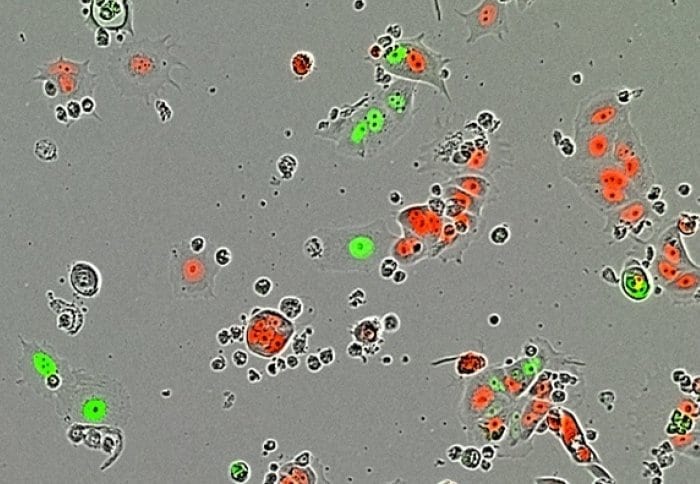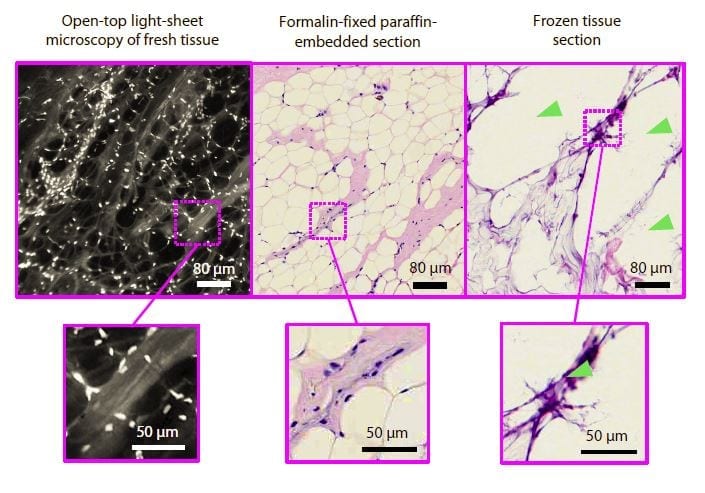
Breast cancer medicines may force some cancer cells into ‘sleeper mode’, allowing them to potentially come back to life years after initial treatment.
These are the early-stage findings from scientists at Imperial College London, who studied human breast cancer cells in the laboratory.
If we can unlock the secrets of these dormant cells, we may be able to find a way of preventing cancer coming back Dr Luca MagnaniStudy author
The team, who studied a group of breast cancer drugs called hormone treatments, say their research opens avenues for finding ways of keeping the cancer cells dormant for longer, or even potentially finding a way of awakening the cells so they can then be killed by the treatment.
Dr Luca Magnani, lead author of the study from Imperial’s Department of Surgery and Cancer said: “For a long time scientists have debated whether hormone therapies – which are a very effective treatment and save millions of lives – work by killing breast cancer cells or whether the drugs flip them into a dormant ‘sleeper’ state.
“This is an important question as hormone treatments are used on the majority of breast cancers. Our findings suggest the drugs may actually kill some cells and switch others into this sleeper state. If we can unlock the secrets of these dormant cells, we may be able to find a way of preventing cancer coming back, either by holding the cells in permanent sleep mode, or be waking them up and killing them.”
Preventing cancer relapse
In the study, published in the journal Nature Communications and funded by Cancer Research UK and the NIHR Imperial Biomedical Research Centre, the team studied around 50,000 human breast cancer single cells in the lab, and found that treating them with hormone treatment exposed a small proportion of them as being in a dormant state.
The team say the ‘sleeper cells’ may also provide clues as to why some breast cancer cells become resistant to treatment, causing a patient’s drugs to stop working, and their cancer to return.
Hormone therapies are used to treat a type of breast cancer called oestrogen-receptor positive. These make up over 70 per cent of all breast cancers, and are fuelled by the hormone oestrogen.
These cancers are usually treated with surgery to remove the tumour, followed by a course of targeted hormone therapy – usually either aromatase inhibitors or tamoxifen, which target oestrogen receptors.
However, around 30 per cent of breast cancer patients taking hormone therapies see their cancer eventually return – sometimes as long as 20 years after treatment. This returning cancer is usually metastatic, meaning it has spread around the body, and the tumours are often now resistant to medication.
Sleeper cells move around the body
Previous work by the same team has investigated why breast cancer cells become resistant to hormone treatment, with findings suggesting cells can make their own ‘fuel’, allowing them to avoid being ‘starved’ by cancer treatment.
Our experiments suggest these sleeper cells are more likely to travel around the body Dr Sung Pil Hong Study author
This new research provides another piece in the puzzle, explained Dr Iros Barozzi, co-author of the study, also from the Department of Surgery and Cancer: ‘These sleeper cells seem to be an intermediate stage to the cells becoming resistant to the cancer drugs. The findings also suggest the drugs actually trigger the cancer cells to enter this sleeper state.”
The research also revealed cells in this dormant sleeper state were more likely to spread around the body, explained Dr Sung Pil Hong, study co-author from Imperial: “Our experiments suggest these sleeper cells are more likely to travel around the body. They could then ‘awaken’ once in other organs of the body, and cause secondary cancers. However, we still don’t know how these cells switch themselves into sleep mode – and what would cause them to wake up. These are questions that need to be addressed with further research.”
The team added that hormone therapies remain one of the most effective treatments against breast cancer, and that further patient research will explore whether taking hormone therapies for longer after initial cancer treatment could prevent cancer cells from waking from their sleeping state.
Dr Rachel Shaw from Cancer Research UK, said: “Although treatments for breast cancer are usually successful, cancer returns for some women, often bringing with it a poorer prognosis. Figuring out why breast cancer sometimes comes back is essential to help us develop better treatments and prevent this from happening. This study highlights a key route researchers can now explore to tackle ‘sleeping’ cancer cells that can wake up years after treatment, which could potentially save the lives of many more women with the disease.”
Learn more: Breast cancer can form ‘sleeper cells’ after drug treatment
The Latest on: Breast cancer
[google_news title=”” keyword=”breast cancer” num_posts=”10″ blurb_length=”0″ show_thumb=”left”]
via Google News
The Latest on: Breast cancer
- NC community mourns loss of teacher, mentor to canceron April 27, 2024 at 12:10 pm
Sarah Haynes, a teacher at Wesleyan Christian Academy, died after a four-month battle with breast cancer. She leaves behind her husband and two kids.
- Here’s How Breast-Cancer Treatments Have Changed For The Betteron April 26, 2024 at 8:36 am
“When I was in training, we would often bypass the rooms of patients with breast cancer, because we were told there was nothing we could do for them,” Dr. Hortobagyi says. “Things have changed dramatically.” Treatment options have advanced “enormously” since then, he notes, and with them has come a better quality of life for breast-cancer patients.
via Bing News










